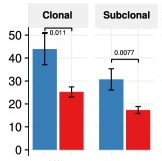I have 2 groups of patients; responders to chemotherapy and non-responders
I have calculated cancer cell fraction (CCF) of a set of driver genes (by variant allele frequency) for each group and I have
> head(dat)
Response CCF
1 Responders 1.0000000
2 Responders 0.5413323
3 Responders 1.0000000
4 Responders 1.0000000
5 Responders 1.0000000
6 Responders 1.0000000
unique(dat$Response)
[1] Responders Nonresponders
Levels: Nonresponders Responders
>
If CCF > 0.95 , the mutation is clonal otherwise sub clonal
I want to show how many clone and subclone are in these two groups by box plot or something similar like below
I have tried this which was nonsense
ggplot(dat, aes(x=Response, y=CCF)) +
geom_boxplot()
Can you help me?
